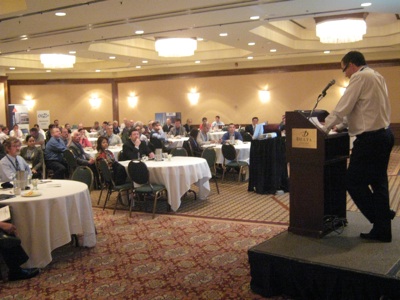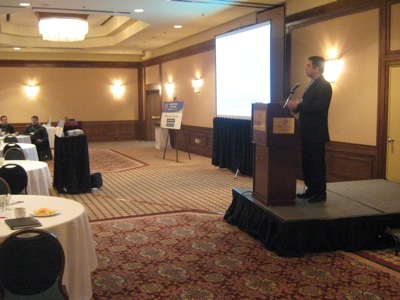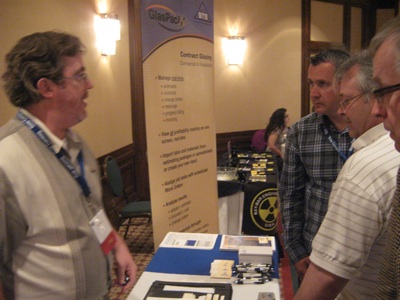
Features
Community
Event reports
Thinking caps on at Glass Connections
May 6, 2011 By Patrick Flannery
 May 6, 2011 – Glass Connections provided a chance for over 100 attendees from all walks of the glass industry to come together on May 3 to learn and network at the Delta Chelsea hotel in downtown Toronto. The event was structured around four educational presentations with tabletop displays and a buffet breakfast and lunch.
May 6, 2011 – Glass Connections provided a chance for over 100 attendees from all walks of the glass industry to come together on May 3 to learn and network at the Delta Chelsea hotel in downtown Toronto. The event was structured around four educational presentations with tabletop displays and a buffet breakfast and lunch.
Glass Connections provided a chance for over 100 attendees from all
walks of the glass industry to come together on May 3 to learn and
network at the Delta Chelsea hotel in downtown Toronto. The Canadian Glass Association event was
structured around four educational presentations with tabletop displays
and a buffet breakfast and lunch.
CGA president Richard Verdon opened the session with a review of the association's recent initiatives, of which Glass Connections was one. The Toronto session was only the second edition of the new program, following the inaugural session in Vancouver last fall. Verdon said the CGA has been working hard to develop new, CGA-affiliated member associations in parts of the country that do not have them, and he hopes to be able to announce new groups in Manitoba and the Maritimes soon. Verdon also thanked the 14 sponsors who made the event possible.
 |
|
| When Pianalto speaks, people listen.
|
CGA Technical Committee chair Leonard Pianalto acted as MC, introducing and thanking speakers.
Chris Barry of Pilkington Glass explained the behaviour of light passing through glass and how it generates different colours. He discussed the best ways to judge the colour of a piece of glass and to avoid common errors in colour matching. He also discussed heat transmission through glass, and dispelled some common misconceptions about insulating glass and how it works best. It seemed like Barry had a startling and/or useful fact on every slide. He also commented that the glass industry is in fact well ahead of the regulations governments are contemplating for energy efficiency, and that present technology can achieve the highest standards likely to be introduced.
Next up was John Carpenter from Clearstream International. Carpenter
presented a number of amazing, high-tech glass applications including
super-insulating glass for use in Antarctica, solar panels for the
Hubble telescope, bricks for the Madrid train bombing memorial that
cause lines of poetry to become visible when lit, and solar power
generators so powerful they have the potential to meet the entire
world's power needs using an area equal to four percent of the Sahara
desert. He went on to discuss using daylight in buildings to provide
high levels of lighting without heat or glare, showing how advanced
glass technology could diffuse light and remove harsh shadows and dark
areas. Imaginations were whirring by the end of his inspiring presentation.

|
|
|
Tabletop displays attracted a great deal of attention.
|
Scott Waechter of Dow Corning commented that it seemed unfortunate to follow the previous two presentations with a discussion of goo, nevertheless he delivered a highly practical look at the differences between organic and silicone sealants and a veritable flood of tips for how to effectively deploy sealants and adhesives in curtain wall applications. "Test, test, test," was his mantra, saying there are simply too many unique variables in every construction project to take anything for granted.
John Kooymans of Read Jones Christoffersen dazzled the group next with his breathtaking architectural glass creations. Glass staircases, bridges, observation boxes at the top of the Sears tower and enormous skylights opening entire malls to the sky – Kooymans is apparently prepared to build absolutely anything out of glass. Kooymans' colleague then attracted the most discussion of the day with his presentation of a 300 m glass pedestrian observation bridge mounted on a semi-circular cantilevered suspension bridge that projects from the side of a mountain overlooking a glacier. It was hard for many in attendance to see how it could work, but the photos were right there for all to see.
Finally, Alex Carrick, chief economist of CanData's economic forecasting group, riveted everyone with a penetrating analysis of the world political and economic scene, culminating in a detailed discussion of the U.S. and Canadian housing markets that supported a number of important forecasts for the next year. This wasn't a view from 30,000 feet, it was a view from orbit from one of the guys behind the numbers we all read about in the paper. And he was funny.
The atmosphere was very convivial, with animated discussions going on between speakers and crowds around the table top displays. The next Glass Connections is planned for this fall in Alberta.
Print this page